
Below
you’ll find photos and histories of some of the telegraph keys in
my small collection. These include everything from the popular J-38
which was contracted for production by the U.S. Army Signal Corps
during WWII, to
the rare El-Key, which was recently restored. I hope you'll find it
interesting.
Lionel J-38 (1942)
The
U.S. Signal Corps’ J-38 was a morse code training key produced in large
numbers during the 1940's. They were produced by several manufacturers,
including Lionel, Signal Electric Manufacturing Company, McElroy,
American Radio Hardware, Telegraph Apparatus Company, and others.
This
particular version was manufactured by Lionel Corporation, of New York,
NY. The easiest way to determine whether or not it’s a Lionel is to
look on the underside, where you’ll see the “L” logo stamped on the
bakelite base. Older variations have the company name stamped between
the trunions on the top of the base. Also, Lionel J-38's have an
obvious “L” design to the metallic part of the key as well.
The key
mechanism by itself, (without the base), is specified as a J-30 by the
U.S. Army.
For more
on the J-38, please click on the following links:
Lionel J-38 Types
J-38 Variations
Telegraph Apparatus Company
J-47 (1945)
There are several other keys
manufactured for use by the Signal Corps, including the J-5A, which was
used around the time of World War I.
Many of the surviving keys are
World War II vintage, and originally came into the hands of amateur
radio operators when they became surplus in the 1950's.
The J-47 is an
example of this, and like the J-38, they were manufactured by many
different companies, causing several variations in style. |
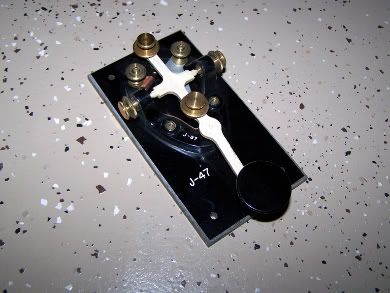 |
J.H. Bunnell &
Company, Navy 26003A Flame Proof Key (1961)
Manufactured
for the Navy, the flame proof key has covered contacts for use in
environments that may have had flammable gasses present.
Please click
here to learn more about the Navy Flame Proof key.
Soviet Military TK hand key
(1965)
The
TK is a Soviet army surplus key with a plastic dust proof cover that
snaps over the top. It also features silver contacts, and a rugged
plastic base. Simple and adjustable, it’s a pleasant key to use. The
key was manufactured by the Ukranian Telegraphy Equipment Plant ZTA, in
Cherkassy. Some of its features are no doubt borrowed from the German
Junker DRP design.
Kent Hand Key (2006)
The Kent Hand Key
is manufactured by R. A. Kent Engineering of England. It is constructed
from solid brass, has a machined wood base, silver contacts, and sealed
instrument ball bearings which reduces side play. The underside is
trimmed with green baize. The key has a weighted base and non-slip feet
for added stability.
Vibroplex
Vibroplex
has been manufacturing telegraph keys since 1890. Although they also
make straight keys and paddles, the name itself is
automatically
associated with one design in particular - the “Bug.” The bug is a
semi-automatic key which uses mechanical vibration to rapidly create
the “dits,” thus allowing for faster sending speeds.
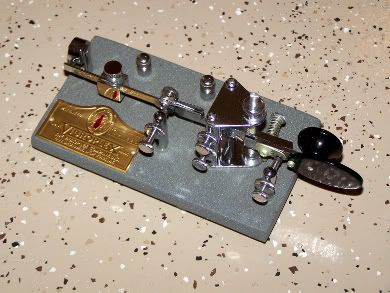
Vibroplex "Champion" |
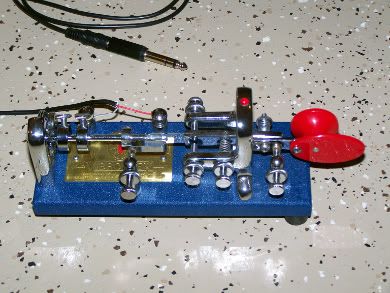
Vibroplex "Blue Racer - 2000" |
Vibroplex “Champion” (1962)
The
Vibroplex “Champion” was the inexpensive alternative to the “Lightning
Bug.”
A popular choice in the 1960's, the Champion’s mechanical
components are similar to the Army Signal Corps J-36 design, which was
manufactured by several companies during WWII. The components, however,
are of a nicer quality and its base is finished in a grey crinkle
paint. One of the defining characteristics of this variation is the
triangular shaped plates and individual posts that make up the yoke
assembly. Click here for more info.
Vibroplex
“Blue Racer 2000" (2000)
Based
on the original “Blue Racer,” which was patented in 1914, the “Blue
Racer 2000" uses the same frame and chrome finished parts as the
“Original Bug.” Its mounted on either a blue or chrome (deluxe) base,
that measures 6 ½" by 2 ½", which is slightly narrower than the
“Original.” Click here for more info. |
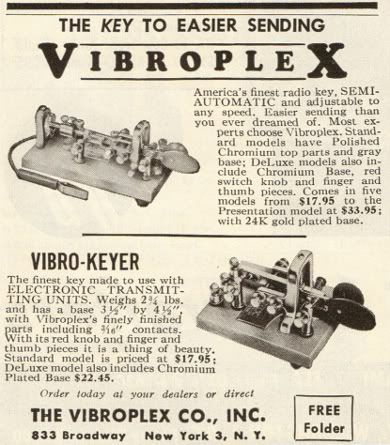 |
El-Key (1959)
The
El-Key is an important paddle in the history of amateur radio. This
single-lever design was the first commercially manufactured paddle
offered to ham radio operators. They were made by R.E. “Bob” Poucel
(W2AYJ) and Sid Shore (K2FC) doing business as "Poucel Electronics
Company," a division of Shore Mfg. Co., of Long Island NY. The name
El-Key is short for “Electronic Keyer.” About 400 were made between
1959 and 1963, and they were available with either a black, light gray,
or chrome base.
Click here to see photos of the
restoration of this key.
Nikey
(1962)
The
Nikey, manufactured by the “Productive Tool and Manufacturing Company
of Stamford, CT”, was the first “truly automatic” iambic paddle,
according to the ad, and is noted as being the first iambic paddle to
advertise in QST magazine. It features stainless and black anodized
parts, green lucite paddles, and a painted steel base.
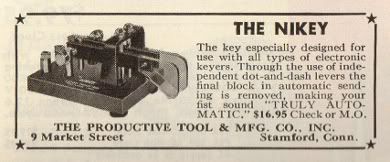 |
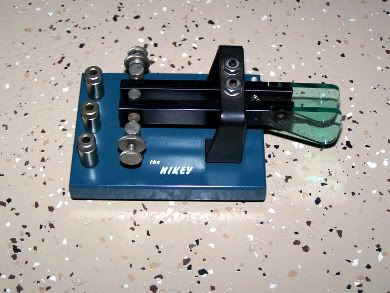 |
The
“FYO” Paddle (1975)
The
“FYO” paddle was invented by Joseph A. Hills (W8FYO) of Dayton, Ohio
and manufactured by Hal Communications Corporation of Urbana, IL. It
was sold for short time between 1975 and 1976 and its unique
three-pivot split ring and spring design was the inspiration for the
modern day Bencher.
This one is the “iambic” version. There was
also a “non-iambic” model made by Joseph Hills and sold for a short
time in the early 1960's. To view Hill's original patent for this
design, click here.
The
Scotia, by Hamco
(1978)
Hamco's
Scotia was the first commercial paddle to incorporate magnetic
tensioning. It has a thick triangular brass plate mounted on a hardwood
base. Some nice features are that the wiring is completely hidden, and
a lever retaining screw helps to make sure they won't fly apart like
the levers on Bencher or FYO paddles tend to do. In 1982, the
Scotia design was bought by the Vibroplex company, and later marketed
as the "Brass Racer."
Bencher BY-1
(2005)
Manufactured
by Bencher, Inc., of Antioch, Illinois, the BY-1 is a two-lever iambic
paddle similar in design to the “FYO,” but with a lighter weight steel
base. With over 100,000 sold, the BY series is the most popular iambic
paddle ever produced. There are several different finishes
available, but they are all mechanically the same. This one has a black
painted base with chrome parts. For more info, click here.
UR5CDX
CT 599 MB Paddle (2010)
Designed
by Yury Shevchenko, (UR5CDX), the CT 599 MB is a two lever iambic
paddle which features a highly polished brass base and components, ball
bearing movement, and solid double silver contacts. This paddle is
unique in that its overall height is only about an inch and a quarter
off the table top. Manufactured in Cherkassy, Ukraine, Yury produces
two other variations of the 599 series, as well as other paddle
designs.
For more info about UR5CDX CT Paddles, please click
here
March
Magnetic R-3A Paddle (2010)
Designed
and built by Michael March (K4QU), of Winchester, Virginia, this
beautiful paddle uses magnetic repulsion instead of springs to create
lever tension. The base and components are machined entirely out of
brass. The R-3A is manufactured by hand with custom details and is only
available by special order. This one features jeweled upper parts and
green acrylic finger pieces.
For more info, please click here
Baumster T1 "Siemens Key" (1943)The
Baumster T1, (also known as the Siemens Key) was built by several
manufacturers during the second World War. It has a stamped-steel base
marked with "Baumster T1 Anf. Z: Ln 26902," where "Baumster T1" means
Type T1, "Anf. Z: Ln" stands for the Luftnachrichtentruppen (the
Airforce Signal Troops), and "26902" is the model designation. It has a
hinged bakelite cover, which is usually brown in color. On the lid is a
lightning bolt and the words "Vor dem Offen Stecker Herausziehen,"
which means "unplug before opening." Inside is a stamp that says "BAL"
which is short for "Bau Amt Luftwaffe." This means that it was approved
for use by the German Air Force.
Speed-X (1940's)
Speed-X
keys were first made by the E.F. Johnson Company and also, for a short
time, by the Les Logan Company of San Franciso, and currently the
Wm. Nye Company. The straight keys have always been known for their
affordability and ruggedness, and many cw operators say they have the
best feel of any straight key on the market. A number of different
variations, as well as platings on the moving parts means there's
several varieties available. The straight key pictured below is an
example of an "Oval" Speed-X, mounted on a wooden base. Its a very
simple and well built key with a cast iron chassis and nickel plated
moving parts. Other variations of these include gold plate (including
chassis), and one with chrome plating. A rectangular version (not
shown), is also popular. The bug (pictured on the right), is a Les
Logan Speed-X Model 510, built in the 1940's. It is a relatively small
bug, with chrome plated moving parts and a black, wrinkle finished
base.
Nikola Tesla JTs RTG-01
The
JTs RTG-01 in an interesting straight key with a bakelite base, metal
cover, and electronic adjustments. The mechanical parts are nickel
plated and the hardware is stainless steel. On the right side is a 5
pin din style connector.
So far, I've found very little
information about the JTs RTG-01, other than the fact that it was used
by the Yugoslav Military in the mid twentieth century. Whether this
means it was designed and manufactured there, I'm not sure. If anyone
has any further information about this, I'd be interested in
learning more. Please contact me here. | 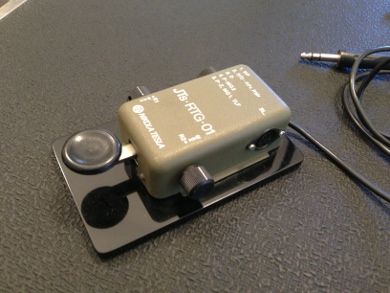 |
Ham Key Iambic Paddle (1970's)
Sold as a cheaper alternative to the more expensive Brown Brothers
keys, the Ham Key, manufactured by the Ham Radio Center of St. Louis,
MO, in the 1970's, is still a favrite among CW operators. Purists may
scoff at its simple construction, and plastic parts, but Ham Keys in NOS or excellent condition are highly sought after by
collectors.
They
do not incorporate jeweled bearings or exotic metals,
and the finish on the moving parts is something less than chrome,
but
they are easily adjusted and maintain that adjustment while sending.
The one pictured to the right has the typical painted marble finish on
the base and red plastic chassis. | 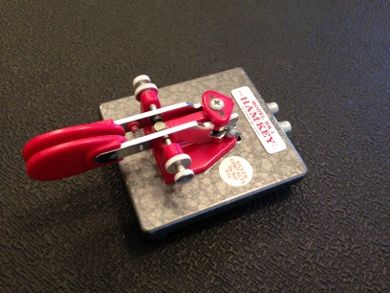 |
|
|